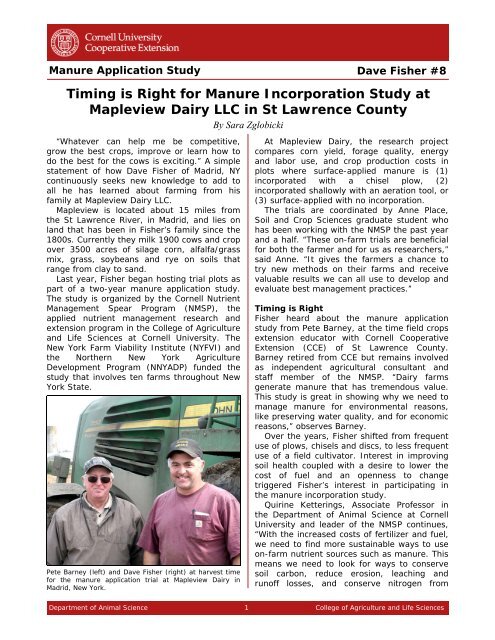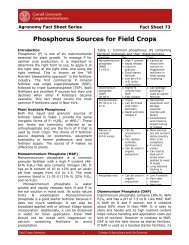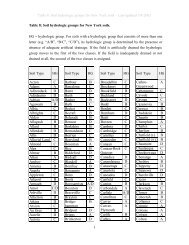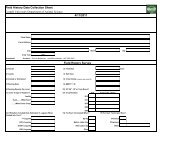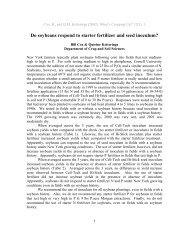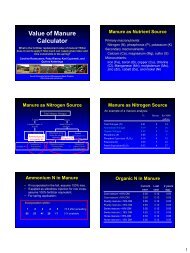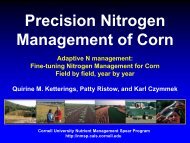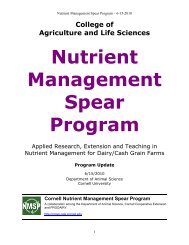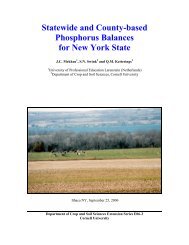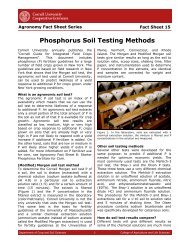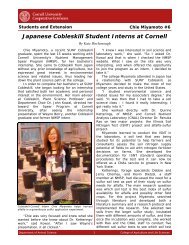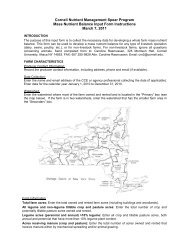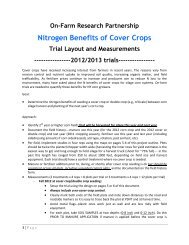Timing is Right for Manure Incorporation Study at Mapleview Dairy ...
Timing is Right for Manure Incorporation Study at Mapleview Dairy ...
Timing is Right for Manure Incorporation Study at Mapleview Dairy ...
You also want an ePaper? Increase the reach of your titles
YUMPU automatically turns print PDFs into web optimized ePapers that Google loves.
<strong>Manure</strong> Applic<strong>at</strong>ion <strong>Study</strong>Dave F<strong>is</strong>her #8<strong>Timing</strong> <strong>is</strong> <strong>Right</strong> <strong>for</strong> <strong>Manure</strong> <strong>Incorpor<strong>at</strong>ion</strong> <strong>Study</strong> <strong>at</strong><strong>Mapleview</strong> <strong>Dairy</strong> LLC in St Lawrence CountyBy Sara Zglobicki“Wh<strong>at</strong>ever can help me be competitive,grow the best crops, improve or learn how todo the best <strong>for</strong> the cows <strong>is</strong> exciting.” A simplest<strong>at</strong>ement of how Dave F<strong>is</strong>her of Madrid, NYcontinuously seeks new knowledge to add toall he has learned about farming from h<strong>is</strong>family <strong>at</strong> <strong>Mapleview</strong> <strong>Dairy</strong> LLC.<strong>Mapleview</strong> <strong>is</strong> loc<strong>at</strong>ed about 15 miles fromthe St Lawrence River, in Madrid, and lies onland th<strong>at</strong> has been in F<strong>is</strong>her’s family since the1800s. Currently they milk 1900 cows and cropover 3500 acres of silage corn, alfalfa/grassmix, grass, soybeans and rye on soils th<strong>at</strong>range from clay to sand.Last year, F<strong>is</strong>her began hosting trial plots aspart of a two-year manure applic<strong>at</strong>ion study.The study <strong>is</strong> organized by the Cornell NutrientManagement Spear Program (NMSP), theapplied nutrient management research andextension program in the College of Agricultureand Life Sciences <strong>at</strong> Cornell University. TheNew York Farm Viability Institute (NYFVI) andthe Northern New York AgricultureDevelopment Program (NNYADP) funded thestudy th<strong>at</strong> involves ten farms throughout NewYork St<strong>at</strong>e.Pete Barney (left) and Dave F<strong>is</strong>her (right) <strong>at</strong> harvest time<strong>for</strong> the manure applic<strong>at</strong>ion trial <strong>at</strong> <strong>Mapleview</strong> <strong>Dairy</strong> inMadrid, New York.At <strong>Mapleview</strong> <strong>Dairy</strong>, the research projectcompares corn yield, <strong>for</strong>age quality, energyand labor use, and crop production costs inplots where surface-applied manure <strong>is</strong> (1)incorpor<strong>at</strong>ed with a ch<strong>is</strong>el plow, (2)incorpor<strong>at</strong>ed shallowly with an aer<strong>at</strong>ion tool, or(3) surface-applied with no incorpor<strong>at</strong>ion.The trials are coordin<strong>at</strong>ed by Anne Place,Soil and Crop Sciences gradu<strong>at</strong>e student whohas been working with the NMSP the past yearand a half. “These on-farm trials are beneficial<strong>for</strong> both the farmer and <strong>for</strong> us as researchers,”said Anne. “It gives the farmers a chance totry new methods on their farms and receivevaluable results we can all use to develop andevalu<strong>at</strong>e best management practices.”<strong>Timing</strong> <strong>is</strong> <strong>Right</strong>F<strong>is</strong>her heard about the manure applic<strong>at</strong>ionstudy from Pete Barney, <strong>at</strong> the time field cropsextension educ<strong>at</strong>or with Cornell Cooper<strong>at</strong>iveExtension (CCE) of St Lawrence County.Barney retired from CCE but remains involvedas independent agricultural consultant andstaff member of the NMSP. “<strong>Dairy</strong> farmsgener<strong>at</strong>e manure th<strong>at</strong> has tremendous value.Th<strong>is</strong> study <strong>is</strong> gre<strong>at</strong> in showing why we need tomanage manure <strong>for</strong> environmental reasons,like preserving w<strong>at</strong>er quality, and <strong>for</strong> economicreasons,” observes Barney.Over the years, F<strong>is</strong>her shifted from frequentuse of plows, ch<strong>is</strong>els and d<strong>is</strong>cs, to less frequentuse of a field cultiv<strong>at</strong>or. Interest in improvingsoil health coupled with a desire to lower thecost of fuel and an openness to changetriggered F<strong>is</strong>her’s interest in particip<strong>at</strong>ing inthe manure incorpor<strong>at</strong>ion study.Quirine Ketterings, Associ<strong>at</strong>e Professor inthe Department of Animal Science <strong>at</strong> CornellUniversity and leader of the NMSP continues,“With the increased costs of fertilizer and fuel,we need to find more sustainable ways to useon-farm nutrient sources such as manure. Th<strong>is</strong>means we need to look <strong>for</strong> ways to conservesoil carbon, reduce erosion, leaching andrunoff losses, and conserve nitrogen fromDepartment of Animal Science 1 College of Agriculture and Life Sciences
manure. Shallow incorpor<strong>at</strong>ion using aer<strong>at</strong>orshas the potential to reduce nitrogen losses andretain more surface residue without the need<strong>for</strong> aggressive soil tillage.” Ketterings adds,“Our research st<strong>at</strong>ion trial showed gre<strong>at</strong>prom<strong>is</strong>e <strong>for</strong> aer<strong>at</strong>ors as manure incorpor<strong>at</strong>iontools but we needed to test th<strong>is</strong> on commercialfarms with a diversity of growing conditionsand soil types. Our project with Dave and nineother New York farms sprang from th<strong>is</strong> need.”2008 Season ResultsIn the 2008 growing season, there were nosignificant differences in corn silage yield, norin silage quality indic<strong>at</strong>ors like mo<strong>is</strong>turecontent, NDF (neutral detergent fiber), protein,starch, lignin, and estim<strong>at</strong>ed milk production,between the aer<strong>at</strong>or and ch<strong>is</strong>el plowtre<strong>at</strong>ments or the surface applic<strong>at</strong>ion withoutincorpor<strong>at</strong>ion <strong>at</strong> <strong>Mapleview</strong>. “The average yieldacross all tre<strong>at</strong>ments was 20.6 tons/acre <strong>at</strong>35% dry m<strong>at</strong>ter,” Place reports.The soil and plant nitrogen tests th<strong>at</strong> weredone as part of the study explained why noyield differences were seen between theincorpor<strong>at</strong>ion tre<strong>at</strong>ments and the surfaceapplic<strong>at</strong>ion. “The Illino<strong>is</strong> Soil Nitrogen Test(ISNT), the Pre-Sidedress Nitr<strong>at</strong>e Test (PSNT),and the L<strong>at</strong>e Season Corn Stalk Nitr<strong>at</strong>e Test(CSNT) all indic<strong>at</strong>ed there was already enoughN from soil organic m<strong>at</strong>ter <strong>for</strong> the crop. Noadditional N was needed <strong>for</strong> th<strong>is</strong> field. As aresult, even though the surface applic<strong>at</strong>ion ofmanure without incorpor<strong>at</strong>ion causes nitrogenvol<strong>at</strong>iliz<strong>at</strong>ion losses, we saw no yielddifferences between the manure applic<strong>at</strong>iontre<strong>at</strong>ments,” Ketterings explains. “We did seehigher yields with both aer<strong>at</strong>or and ch<strong>is</strong>elincorpor<strong>at</strong>ion <strong>at</strong> farm-trials where the loss of Nfrom the surface applic<strong>at</strong>ion resulted in anitrogen deficiency. And, in those trials, theaer<strong>at</strong>or did as good a job as the ch<strong>is</strong>el plowwith conserv<strong>at</strong>ion of the nitrogen from themanure.”While comparing the two incorpor<strong>at</strong>ion tools<strong>at</strong> h<strong>is</strong> farm, F<strong>is</strong>her noticed there was less fueland horsepower required to pull the Aerway ®versus the ch<strong>is</strong>el plow. F<strong>is</strong>her says, “Over thech<strong>is</strong>el, we’re saving probably a couple gallons[of fuel] per acre. After trying out the Aerway ®<strong>for</strong> the first time last year, 60% of manureapplied th<strong>is</strong> year was incorpor<strong>at</strong>ed with theAerway ® . “Yields are <strong>at</strong> least as good as lastyear,” F<strong>is</strong>her added.Benefits of On-Farm ResearchAs an extension educ<strong>at</strong>or, Barney was a keyplayer in making research findings accessibleto farmers and ensuring research relevancy.He emphasizes the importance of the teambased,on-farm, research approach used bythe NMSP. “Good working rel<strong>at</strong>ionshipsbetween the university, extension and farmingcommunities are essential. Th<strong>is</strong> ensuressuccess <strong>for</strong> all parties involved, including thepriv<strong>at</strong>e sector.” As Barney continued, “Thesetypes of projects are multipliers. People willlearn from their experiences with the research,and will pass th<strong>at</strong> on to anyone they interactwith.”For F<strong>is</strong>her, involvement with research <strong>is</strong>nothing new. As Barney, whose family hasbeen working with F<strong>is</strong>her <strong>for</strong> over 45 years,comments of F<strong>is</strong>her, “I have respect <strong>for</strong> wh<strong>at</strong>he does with the farm. He’s very innov<strong>at</strong>iveand <strong>is</strong> always willing to look through researchand see where it fits h<strong>is</strong> oper<strong>at</strong>ion.”“Th<strong>is</strong> study brings up questions <strong>for</strong> me aboutwh<strong>at</strong> <strong>is</strong> happening on the other farms in thetrial.” Says F<strong>is</strong>her, “I like to learn how to dothings better and cheaper. I’ve always doneprojects with Cornell Cooper<strong>at</strong>ive Extension,whether with cows or crops. I learn from thepeople who come out to the farm, and ouremployees learn too.”(October 23, 2009)The Nutrient Management Spear Program (NMSP) <strong>is</strong> an applied research, teaching and extension program <strong>for</strong> fieldcrop fertilizer and manure management on dairy and livestock farms. It <strong>is</strong> a collabor<strong>at</strong>ion among faculty, staff andstudents in the Department of Animal Science, Cornell Cooper<strong>at</strong>ive Extension, and PRO-DAIRY. Our v<strong>is</strong>ion <strong>is</strong> to assesscurrent knowledge, identify research and educ<strong>at</strong>ional needs, facilit<strong>at</strong>e new research, technology and knowledge transfer,and aid in the on-farm implement<strong>at</strong>ion of str<strong>at</strong>egies <strong>for</strong> field crop nutrient management including timely applic<strong>at</strong>ion o<strong>for</strong>ganic and inorganic nutrient sources to improve farm profitability while protecting the environment. An integr<strong>at</strong>ednetwork approach <strong>is</strong> used to address research, extension and teaching priorities in nutrient management in New YorkSt<strong>at</strong>e. For more in<strong>for</strong>m<strong>at</strong>ion on NMSP projects and extension/teaching activities, v<strong>is</strong>it the program website(http://nmsp.css.cornell.edu) or contact Quirine Ketterings <strong>at</strong> qmk2@cornell.edu or (607) 255-3061.Department of Animal Science 2 College of Agriculture and Life Sciences


